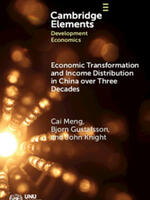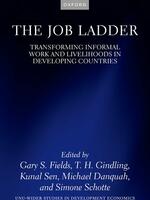Filter by...
Reset all
Publications (404)

It is arguable that the most important event in the world economy in recent decades has been the rise of China, from being on a par with sub-Sahara Africa at the start of economic reform to being an economic superpower today. That rise remains under-researched. Moreover, the great structural changes...
Book Chapter
This peer-reviewed research is available free of charge. UNU-WIDER believes that research is a global public good and supports Open Access.
From the book:
Tasks, Skills, and Institutions
Working Paper
pdf
– Guidelines for NEP implementation
This paper documents the state of elementary education in India and China since the 1960s, key lessons for India from China’s shift in focus from ‘quantity’ to ‘quality’, and evidence-based guidelines for effective implementation of India’s New Education Policy 2020 (NEP 2020). The divergent policy...
Book Chapter
This peer-reviewed research is available free of charge. UNU-WIDER believes that research is a global public good and supports Open Access.
– Structural transformation, inequality, and inclusive growth in China
From the book:
The Developer’s Dilemma
Working Paper
pdf
– Lessons from 19th-century America and 21st-century China
How do modern fiscal states arise? Perhaps the most dominant explanation, based on the European experience, is that democratic institutions that limited the extractive power of states—exemplified by the 1688 Glorious Revolution in England—paved the way for the rise of fiscal capacity and subsequent...

– A case study of social mobility research in the Global South
Part of Journal Special Issue
Social mobility in developing countries
Working Paper
pdf
– A case study of the Eastern Industry Park
Despite the Ethiopian government’s commitment to attracting foreign direct investment to its emerging manufacturing sector and its shared interests with Chinese private businesses in building profitable investments, relations between Chinese private businesses and the Ethiopian government are not...
Working Paper
pdf
This paper examines the evolution of China’s industrial and occupational structure in the last two decades and its impact on wage inequality. We find that non-routine cognitive and interpersonal tasks have increased, while routine cognitive tasks first increased and then declined. Occupation...
Journal Article
This peer-reviewed research is available free of charge. UNU-WIDER believes that research is a global public good and supports Open Access.
– Evidence from the Han and ethnic minorities in China
This study investigates the unexpected impact that enforcing birth control policies in China has upon the educational stratification between the Han majority, the policy target group, and ethnic minorities, a partially excluded group. Exploring county-level variation in the value of fines levied for...
Book Chapter
This peer-reviewed research is available free of charge. UNU-WIDER believes that research is a global public good and supports Open Access.
– Different economic models but similarly low levels of socioeconomic mobility
From the book:
Inequality in the Developing World
Book Chapter
This peer-reviewed research is available free of charge. UNU-WIDER believes that research is a global public good and supports Open Access.
– Structural change, transition, rent-seeking and corruption, and government policy
From the book:
Inequality in the Developing World
Working Paper
pdf
Understanding the relationship between income inequality and economic growth is of utmost importance to economists and social scientists. In this paper we use a Bayesian structural vector autoregression approach to estimate the relationship between inequality and growth via growth and inequality...
Working Paper
pdf
– The case of BRICS
As the world battles with the triple problems of social, economic, and environmental challenges, it has become important to focus both policy and research efforts on these. Therefore, this study examines the effect of wealth inequality on CO2 emissions in five emerging economies: Brazil, Russia...
Working Paper
pdf
The informal sector has long been viewed as a locus of the disadvantaged, unskilled, and inexperienced workers in under-developed and developing economies. Workers in the informal sector, however, can learn skills and gain experience that could help them switch to better-paying jobs in the formal...
Displaying 16 of 404 results
 Join the network
Join the network